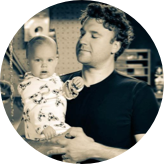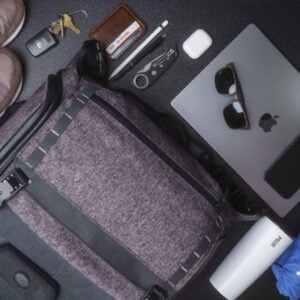It’s time for another warm and sunny baby monitor review! Will the Summer Infant Pixel Zoom HD leave you with a comfortable tan or end up burning you?
Alright, enough with the puns. Keep reading for our full opinion of the Summer Infant baby monitor, or kick back and start with our 6-minute video review first:
An In-Depth Summer Infant Pixel Zoom HD review
Keep it going with the puns, but don’t let the name fool you: the Summer Infant Pixel Zoom works all-year and probably is best used indoors. It’s a non-Wi-Fi video monitor, which has its ups and downs. But we wanted to know more. So John spent a few months with the baby monitor at home, taking its temperature and hoping for a good forecast.
Did he get it? Let’s find out.
Heads up: Fathercraft also participates in the Amazon Services LLC Associates Program, which helps us earn fees by linking to Amazon.com and affiliated sites.
What, exactly, is the Summer Infant Pixel Zoom HD?
It’s a pretty good video monitor, actually. The Summer Infant falls into the non-Wi-Fi category of baby monitors, which means that it doesn’t work through the internet. Instead, the parent unit and camera are directly connected to each other via a radio frequency signal.
That makes it more like the Eufy and Infant Optics DXR-8, and less like Wi-Fi options like the Nanit, Miku, and Lollipop. We’ve got reviews of all of those, by the way, and you can find them here.
Full disclosure: generally speaking, we prefer Wi-Fi baby monitors. They don’t require parent video units, which are usually bulky, require charging, and don’t come with great range. But traditional monitors do have their advantages, like a faster and more reliable connection (when you’re in range) and fewer worries about getting hacked—if you’re worried about that sort of thing.
The Infant Pixel Zoom is just one of Summer’s line of video baby monitors and falls about in the middle price-wise. It comes with a full 1-year warranty. Does it hold up to its relatively steep price? Let’s dig in and find out.
Unpacking the box

Well, it starts with lots of manuals. You should probably read at least some of those, because they’re full of great tips about how far to place the monitor from your baby for safety and the best picture, charging time for your parent unit, etc. But that’s just the paperwork. It gets really fun when you get to the electronics.
The camera unit
The camera looks like you would expect—not a lot of fanciness or bells and whistles. It’s mainly white, and you can’t customize the color like you can with a more playful design like the Lollipop. Bonus: you won’t be tempted to eat it.
What you do notice is the way in which the lens can pan and tilt. The camera sits on top of its mount, which can go up and down. The camera head can then rotate left and right, giving you full motion but also some odd camera angles if you’re not careful. But it works well after you get some practice. Kinda like the new parent version of that remote-control car you used to have.
On the inside, the lens delivers a 720p high-def picture that allows you to zoom digitally. It also has an extra light you may never want to use … never. But more on that later.
The parent unit
Next, you’re looking at a 5-inch monitor that can display that 720p picture clearly. It looks a little like a handheld gaming system, although you probably don’t want to start going nuts on those A-B combinations. From the parent unit, you can steer your camera and turn on all those fancy features.
The batteries on the parent unit are rechargeable. You’ll have up to 800 feet of range between the parent and camera unit. Looking to set it down without taking your eyes off that little one? Park the parent unit like your motorcycle and use the kickstand.

The power adapters
More specifically, two power adapters. One is for the camera and should always be attached. The other is to charge your parent unit.
Heads-up: don’t try to install this gadget right before your baby’s bedtime. Summer Infant recommends a parent unit charge of at least seven hours before you use it for the first time. Does it explode if you don’t follow that recommendation? Do you really want to find out?
Installation options: cord management and wall mount
The last two things in the box are cord management clips and a wall mount. You can set the Pixel Zoom HD on any bookshelf, or use the included anchor to mount it to your wall.
Either way, the simple clips included in the box help you keep those cords out of your little one’s octopus-like reach. They don’t hide the cords, but they do make sure that nothing gets ripped down or broken. We’ll call that a win. [Obligatory safety note: experts recommend all cords be at least 3 feet from your baby’s crib to prevent your baby from grabbing a cord and accidentally wrapping it around her neck.]
Setting up the Summer Infant Pixel Zoom baby monitor
The actual setup? It’s like a summer breeze. You honestly can’t do it wrong. Power up the camera, turn on the monitor, and the two automatically find each other. No passwords, manual, or search required.
You do need to think about the placement of the monitor, though. Summer Infant recommends placing the monitor between six and eight feet away from the crip to focus the picture. That’s quite a lot. If you’re wall mounting, you might not be able to get to that distance.

Basic Pixel Zoom HD features
Once it’s set up, you get the full opportunity to play with its features. Let’s get some basic ones out of the way before we dive into the exciting stuff:
- Two-way audio, allowing you to talk back to your baby when they just can’t stop babbling.
- White noise and lullaby sound if you just don’t feel like talking back and want to rely on the machines instead.
- A six-times digital zoom that gets you to that snuggly close-up when you need a boost.
- Time and temperature display for your nursery that shows up right on your parent unit.
Ready for the advanced stuff? Alright. We won’t leave you hanging, on the wall or otherwise. Three features are worth digging in with more detail:
1) Sleep Zone Virtual Boundary Box
Think of it as a perimeter within the parent unit. It’s a box on the inside of your screen that tells the monitor to send you a sound alert when your baby moves within the box. It’s a useful feature if you’re worried about too much movement or some baby calisthenics during the night.
It’s a neat feature. And hey, the sound will also alert you if something enters the boundary area, so it has that going for it.
You don’t have to go along with the default feature, either. If you go into the menu settings on the parent unit, you can customize the area you want to focus on. get up close and personal, or get that wide shot—it’s up to you! You should get ready for plenty of alerts if you set it on wide mode, though.
Once you’ve got the settings right where you want them, you can use a button on top of the parent unit to toggle the feature on and off. Pretty useful.
2) Voice-Activated Screen Wake Up (VOX)
Distinguishing feature number two is simple but sweet. The full name kind of gives it away, but you might not recognize it by its VOX acronym. I’m not yelling, you’re yelling.
Anyways, VOX means that any noise around the camera will turn on the screen so you can see what’s going on even when you’re on power-saver mode. That’s pretty useful if you can’t plug in the parent unit and have to worry about the battery going low.
We should note here that you’ll hear the sound regardless, so it’s not like you have to worry about missing that little cry without VOX. This just helps you check out what’s going on without hitting a button, which can come in handy during a sleepy midnight wakeup.
3) Moonlite Night Vision Boost
Finally, let’s talk about what might be the most confusing feature of the whole device. It’s essentially a spotlight right under the camera itself that brightens up the room so the camera can function better.
Here’s how the manufacturer describes Moonlite:
Subtly illuminate your camera’s viewing area for a clearer, temporary, in-color view of baby in the dark.
Here’s how John described the exact same feature after testing it:
I’m not sure why you would want to use this feature other than wanting to wake up your baby, because this light is super bright.
The awesome, the wish it were different, and a verdict
The awesome
- The setup. It’s extremely quick and simple, much easier than a lot of the Wi-Fi alternatives out there. Plug it in, and turn it on. When using it for the first time, you do need to keep the 7-hour charging time in mind.
- The picture quality. Honestly, it’s pretty great. Unlike many other radio frequency units, it’s on par with Wi-Fi monitors like the Nanit and Miku.
- The zoom button. Along with the easily adjustable camera angles, the zoom button on the parent unit helps you adjust to any position and depth you need without having to go through a complicated menu.
- The night vision. It’s actually impressively clear, allowing you to see your little one even in the darkest of nights without a lot of grain. That only makes the Moonlite boost feature more questionable—you just don’t need it.

The wish it were different
- The white noise volume. White noise is great, but this monitor pretty much blasts it out there. Even on the lowest setting, it might be too loud for sensitive babies (and parents). Plus, you only have three volume settings in total.
- The white noise functionality only stays on for about 20 minutes, and there is no way to change that to all night. Looking to get baby to sleep? Great. Need her to keep sleeping? Not so great.
- The size of the parent unit. It’s pretty big, about as wide as a typical smartphone and twice as thick. That makes carrying it around a little difficult, especially if you’re already carrying that cell phone with you.
- The button placement. Features like the boundary box are great, but they’re positioned on top of the unit. As you pull it out of your pocket, you’ll press them more often than you’d like. Not awful, but it can get annoying.
- The menu system. It’s not very intuitive, and you’ll need some time to familiarize yourself with it. You also can’t customize all that much, from limited volume settings to a limited tilt range, so that could be a little more helpful.
- The price is pretty high at $250. That’s about as much as you’d pay for a top-line smart Wi-Fi monitor, which comes with a lot more features. Can’t help but think removal of that the almost useless Moonlite feature could easily shave some dollars off that price tag.
The verdict
Here at Fathercraft, we’re pretty tough on traditional monitors because they don’t tend to have the same functionality or picture quality. That wasn’t actually the case here. The Summer Infant Pixel Zoom HD might be expensive, but it’s a good option for anyone weary of the Wi-Fi alternatives.
Even the negative items above are not complete show stoppers. They might bother you like they bothered John (and his kids when that light started shining), but they’re no deal breakers. It’s not a perfect monitor, and we still prefer Wi-Fi alternatives, but if you’re worried about getting hacked this is a good one to turn to.

Summer Infant Pixel Zoom HD pricing and add-ons
The $249 price tag is pretty much non-negotiable, and it’s identical on both the manufacturer’s website and Amazon. That said, you can get even fancier (and deeper into your wallet).
Looking for those multiple angles (or kids)? Add a Summer Infant Pixel Zoom HD extra camera. For the low (read: high) price of $140, you can add a second lens that streams to the same parent unit. You can stream up to 4 total cameras, allowing you to monitor multiple rooms if you’re so inclined.
It’s important to do the math, of course: One main unit plus three extra cameras comes out to $670. That’s a hefty bit of money for a baby monitor.
Comparing the Summer Infant Pixel Zoom HD to the Infant Optics DXR-8
We reviewed the Infant Optics DXR-8 last year and weren’t impressed, despite its top-selling Amazon status. Here’s how it compares to the Summer Infant Pixel Zoom HD:
- Technology: both cameras transmit their image via radio signal instead of Wi-Fi. That’s a good thing if your Wi-Fi is unreliable or you’re worried about those hackers.
- Price: The Pixel Zoom, at $250, clocks in almost $100 above the DXR-8 ($165). Both are within the same price range as comparable (but feature-richer) Wi-Fi alternatives.
- Range: the Pixel Zoom HD boasts 800 feet, while the DXR-8 only has 700-feet of ‘unobstructed range’. It seems to drop its signal much faster than its more expensive counterpart.
- Setup: one needs a color-coded battery attachment and a sharp pen to attach it (DXR-8), the other has an integrated battery. Both connect parent and camera units automatically once charged and turned on.
- Picture Quality: We were surprised positively by the 720p resolution of the Pixel Zoom, probably because the 360p resolution (twice as bad, or half as good) or the DXR-8 left much to be desired. Plus, the night vision on the cheaper option was much worse than the Pixel Zoom, even without that weird spotlight.
What should I do now?
Well, you made it to the end of this review. But, if you’re still researching monitors, you can see all of our reviews, our pick for the best baby monitor of 2020, and more right over this way. We’ll see you there.







